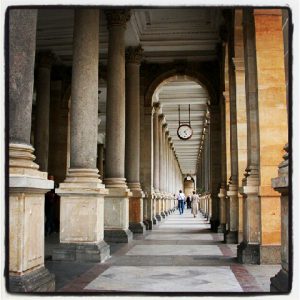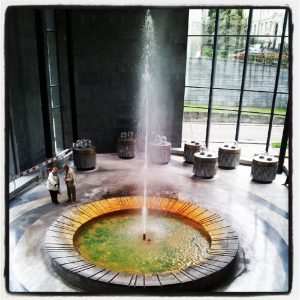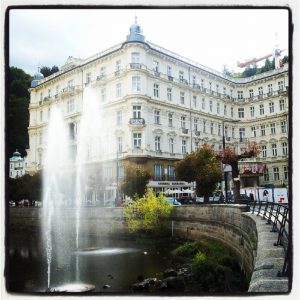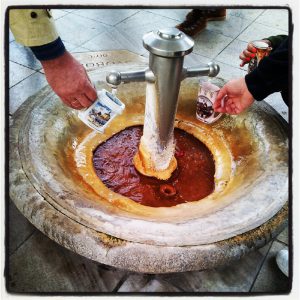The romantic spa town of Karlovy Vary (Karlsbad)
By Tracy A. Burns
 This popular west Bohemia spa town sometimes referred to as Carlsbad or Karlsbad is noted for its 13 curative thermal springs and approximately 300 smaller springs. Patients and tourists take strolls along its elegant colonnades. Founded by Holy Roman Emperor and Bohemian King Charles IV in the middle of the 14th century after one of his dogs stumbled upon the Hot Spring, Karlovy Vary is a magnet for famous personalities including writers Johann Wolfgang von Goethe and Franz Kafka as well as Russian Czar Peter the Great and composer Ludwig van Beethoven. It is also known as the home of Czech liqueur Becherovka and the glass manufacturer Moser.
This popular west Bohemia spa town sometimes referred to as Carlsbad or Karlsbad is noted for its 13 curative thermal springs and approximately 300 smaller springs. Patients and tourists take strolls along its elegant colonnades. Founded by Holy Roman Emperor and Bohemian King Charles IV in the middle of the 14th century after one of his dogs stumbled upon the Hot Spring, Karlovy Vary is a magnet for famous personalities including writers Johann Wolfgang von Goethe and Franz Kafka as well as Russian Czar Peter the Great and composer Ludwig van Beethoven. It is also known as the home of Czech liqueur Becherovka and the glass manufacturer Moser.
The Hot Spring Colonnade (Vridelna kolonada)
 Housing the biggest and hottest spring, this colonnade was formerly a wrought-iron structure built in 1878 and 1879 by the Viennese architectural due of Ferdinand Fellner and Hermann Helmer. In 1975 Jaroslav Otruba gave it a functionalist facelift. The result is a hideous structure that mars the beauty of the town. The Hot Spring Colonnade is made of glass and reinforced concrete. The Hot Spring (Vridlo) belches out 2,000 liters of mineral water per minute, rising to an impressive height of 12 meters. A glass prism-shaped dome covers this spring that is used for bathing and drinking. There are five more seeps as well. An underground tour below the wrought-iron colonnade designed in the late 19th century illustrates how souvenirs are coated in mineral water and how the water is distributed to hotels throughout the city, for instance.
Housing the biggest and hottest spring, this colonnade was formerly a wrought-iron structure built in 1878 and 1879 by the Viennese architectural due of Ferdinand Fellner and Hermann Helmer. In 1975 Jaroslav Otruba gave it a functionalist facelift. The result is a hideous structure that mars the beauty of the town. The Hot Spring Colonnade is made of glass and reinforced concrete. The Hot Spring (Vridlo) belches out 2,000 liters of mineral water per minute, rising to an impressive height of 12 meters. A glass prism-shaped dome covers this spring that is used for bathing and drinking. There are five more seeps as well. An underground tour below the wrought-iron colonnade designed in the late 19th century illustrates how souvenirs are coated in mineral water and how the water is distributed to hotels throughout the city, for instance.
Mill Colonnade (Mlynska kolonada)
The Mill Colonnade is the largest of the five colonnades, measuring 132 meters long by 13 meters wide. The pseudo-Renaissance style hall was constructed by well-renowned Czech architect Josef Zitek from 1871 to 1881. In addition to the 24 majestic columns on its roof, the colonnade’s elaborate decoration includes 12 allegorical statues above the portico. Stone reliefs depicting major events in the town’s history decorate the orchestra pit. The Mill Colonnade houses the seeps of five thermal springs.
Park Colonnade (Sadova kolonada)
This wrought-iron architectural gem is all that remains of the Blanensky Pavilion where a concert and restaurant hall used to be located. Set in romantic Dvorak Park, the Park Colonnade has a 50-meter long veranda, covered with wrought-iron decoration in Neo-Renaissance style. It was reconstructed in 2001 and 2002, when it obtained the Snake Spring, which features a spout resembling a snake’s head. On the way to the Park Colonnade, stop at the Liberty Pavilion. Housing a spring discovered in 1865, the Liberty Spring Pavilion has a Swiss appearance and a romantic flair.
The Castle Colonnade (Zamecka kolonada)
A tower is all that remains of a Gothic castle built by Holy Roman Emperor Charles IV on this site. The colonnade features two parts – the Upper Spring Colonnade, open to the public, and the Lower Spring Colonnade, which only guests of the Castle Spa can use. A stunning Art Nouveau relief is cut into the rock of the Lower Castle Spring.
The Market Colonnade (Trzni kolonada)
The 1883 exquisite work of Fellner and Helmer has a façade resembling a Swiss cottage adorned with delicate lace motifs, giving it a light and airy look. It is also notable for its gabled roof, majestic columned arcade decorated with wood carvings, and its relief depicting the legend of the founding of the town, portraying Emperor Charles IV’s hunting dogs discovering the Hot Spring in the middle of the 14th century. This stunning structure has become a symbol of the town.
The Grandhotel Pupp
 Exuding elegance and grandeur, the Grandhotel Pupp is one of the most well-reputed hotels in Europe. Famous films have been shot there. Prominent personalities throughout the centuries have enjoyed the luxuries of this Neo-Baroque building complex. The Grandhotel Pupp hosts the Karlovy Vary International Film Festival, as prominent artists from around the world temporarily call the 228-room hotel home. While the history of the hotel dates back to 1701, confectioner Jan Jiri Pop was responsible for making the Grandhotel Pupp into a world-renowned hotel that thrived in the early 19th century. Viennese architects Fellner and Helmer redesigned the buildings into one complex in French Neo-Renaissance style between 1892 and 1893. It took on the appearance of a Baroque palace in 1907. Its Ceremonial Hall features Neo-Baroque and Rococo elements that include Rococo rocailles. Art Nouveau skylights also adorn this space.
Exuding elegance and grandeur, the Grandhotel Pupp is one of the most well-reputed hotels in Europe. Famous films have been shot there. Prominent personalities throughout the centuries have enjoyed the luxuries of this Neo-Baroque building complex. The Grandhotel Pupp hosts the Karlovy Vary International Film Festival, as prominent artists from around the world temporarily call the 228-room hotel home. While the history of the hotel dates back to 1701, confectioner Jan Jiri Pop was responsible for making the Grandhotel Pupp into a world-renowned hotel that thrived in the early 19th century. Viennese architects Fellner and Helmer redesigned the buildings into one complex in French Neo-Renaissance style between 1892 and 1893. It took on the appearance of a Baroque palace in 1907. Its Ceremonial Hall features Neo-Baroque and Rococo elements that include Rococo rocailles. Art Nouveau skylights also adorn this space.
The Hotel Thermal
While the Grandhotel Pupp has an elegant appearance, the tall Hotel Thermal is an eyesore on the city’s panorama. This steel structure with concrete panels and steel frames includes a hotel, sanatorium, and festival halls. Near the hotel, there is a large pool with thermal water. It has a unique appearance because it was carved into the rock itself.
Saint Peter and Paul Cathedral
Founded in 1862, the architecture of this Russian cathedral was inspired by the sacral buildings in Yaroslavl and Moscow during the 17th century. Its four small blue domes with copper sheet roofing and its golden dome in the center are dominants of the Karlovy Vary panorama. It is situated in a hilly, residential district with leafy, quiet streets. The façade boasts exquisite paintings by Russian artists. The interior does not disappoint, either. A large crystal chandelier is decorated with 132 candles. Icons and altar cross shipped from Russia adorn the interior. The rich woodcarving at the main altar is also impressive.
The Church of Saint Mary Magdalene
This Baroque church crowned with a dome and a lantern was designed by leading architect Kilian Ignac Dientzenhofer from 1732 to 1737. Inside, exquisite murals show the Evangelists. The main altar hails from 1752. The crypt of the most significant Baroque building in the town features an altar made of aragonite. It is located behind the Hot Spring Colonnade.
The main post office
An architectural gem, the majestic main post office dates back to the turn of the 20th century when it was built in a German Renaissance style. Large, allegorical sculptures represent telegraph, sea and rail transportation, and postal services. It also is intriguing from a technical standpoint. Above the stairway, one can still see the original telephone and telegraphic lines.
The Municipal Theatre and the Imperial Spa
The design of this theatre combines Baroque and Rococo, courtesy of Fellner and Helmer from 1884 to 1886. The ceiling features spectacular paintings by artists Gustav Klimt, his brother Ernst and their friend Franz Matsch. These three decorated the impressive curtain, too. The Imperial Spa (Spa I) is another architectural feat by the Viennese duo. It is a French Neo-Renaissance building boasting a breathtaking interior. The spa is noted for its peat baths.
A few museums
The rustic, brick masonry of the structure stands out at the Jan Becher Museum near the bus and train station. Boasting elements of the historicist style, it has an intriguing façade with pilasters framing wide panels between windows. Here visitors tour the original factory cellars and become acquainted with the history of Becherovka and its manufacturing. The town museum is intriguing, too, with its eclectic artworks ranging from statues made around 1400 to weapons and armor from the Thirty Years’ War of the 17th century to colored and Moser glass hailing from the 19th and 20th centuries. Placards relating to the history of the town are in Czech only.
The funiculars
A funicular, erected in 1907, leads from Theatre Square to the Hotel Imperial. This attraction is the oldest tunnel funicular in Europe. In funicular, it is possible to reach the forests surrounding the city or to the park of the Hotel Imperial, built from 1910 to 1912, when the spa was in its Golden Age. There is another funicular in the town as well. Built from 1911 to 1912, this underground funicular takes visitors to the top of Friendship Heights and offers spectacular panoramas of the town at the Diana Lookout. Climb 150 steps to the top or take the elevator.
Numerous possibilities
 Stop at the Elephant Café for a coffee and take note of its statue of a golden elephant. The foyer is lined with tiles made of straw. The architectural masterpiece that is Karlovy Vary has numerous attractions. Whether sightseeing, exploring the springs, or taking a walk in the surrounding forest, visitors have many possibilities for enjoying one of the most famous Czech towns in one of the most romantic settings in the country.
Stop at the Elephant Café for a coffee and take note of its statue of a golden elephant. The foyer is lined with tiles made of straw. The architectural masterpiece that is Karlovy Vary has numerous attractions. Whether sightseeing, exploring the springs, or taking a walk in the surrounding forest, visitors have many possibilities for enjoying one of the most famous Czech towns in one of the most romantic settings in the country.



